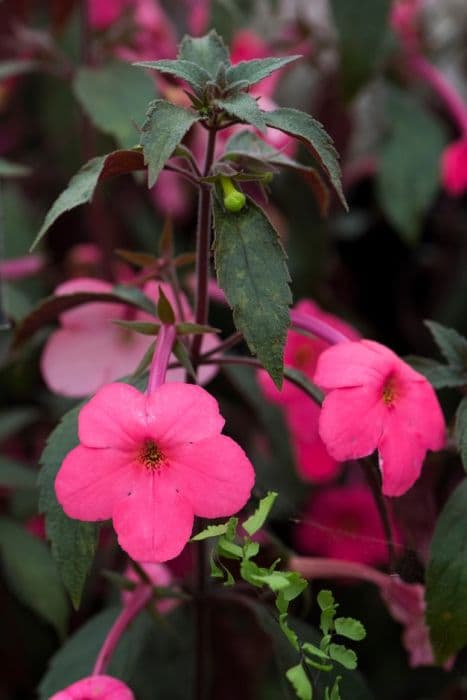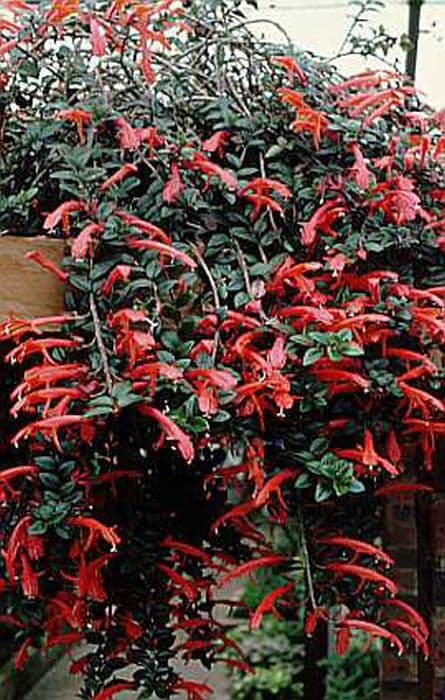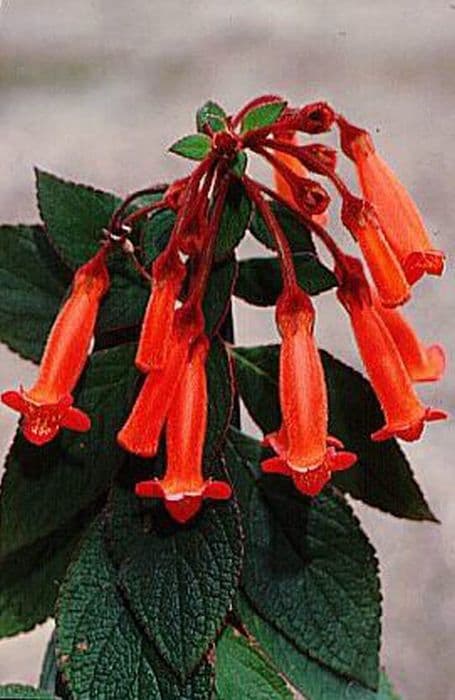Cape primrose 'Pearl' Streptocarpus 'Pearl'

ABOUT
'Pearl' is an evergreen perennial with strap-shaped, wrinkled leaves. This cultivar is free-flowering over a long season, bearing up to ten clear white flowers with a pale yellow throat on each flower stem
About this plant
 Names
NamesFamily
Gesneriaceae
Synonyms
Cape Primrose, African Violet
Common names
Streptocarpus 'Pearl'.
 Characteristics
CharacteristicsLife cycle
Perennials
Foliage type
Evergreen
Color of leaves
Green
Flower color
White
Height
1 foot (30 cm)
Spread
1 foot (30 cm)
Plant type
Herb
Hardiness zones
10
Native area
Africa
Benefits
 General Benefits
General Benefits- Easy to care for – Streptocarpus 'Pearl' does not require extensive care or maintenance, making it suitable for gardeners of all skill levels.
- Long blooming period – This plant can produce flowers for much of the year when its basic needs are met.
- Compact size – It typically remains small, making it an ideal choice for indoor spaces or small gardens.
- Variety of colors – The flowers can come in various shades, providing visual interest and appeal.
- Can be propagated easily – It can be propagated from leaf cuttings, allowing growers to create more plants with ease.
- Aesthetic appeal – With its attractive foliage and flowers, it can enhance the visual appeal of the space it occupies.
- Low light requirements – Streptocarpus 'Pearl' can thrive in lower light conditions, which is beneficial for indoor environments.
 Medical Properties
Medical PropertiesThis plant is not used for medical purposes.
 Air-purifying Qualities
Air-purifying QualitiesThis plant is not specifically known for air purifying qualities.
 Other Uses
Other Uses- Edible Art: Some varieties of Streptocarpus, including 'Pearl', are edible and can be used to add color and a mild flavor to salads or as a decorative edible garnish for dishes.
- Photography Subjects: Streptocarpus 'Pearl' with its attractive flowers is popular among photographers and can be used in macro photography projects.
- Educational Tool: Horticulture educators can use Streptarpus 'Pearl' to teach botany and plant hybridisation techniques due to their diverse genetic makeup.
- Expression of Commemoration: Streptocarpus 'Pearl' can be given as a gift for anniversaries or significant events due to the “pearl” association with milestones.
- Plant Competitions: Streptocarpus 'Pearl' can be grown for entry into specific houseplant or flower show competitions, showcasing the grower's skill.
- Humidity Indicator: The plant's need for high humidity can serve as a natural indicator of the surrounding humidity levels in a grower's environment.
- Stress Relief: The care and maintenance of Streptocarpus 'Pearl', like other houseplants, can provide a relaxing hobby for people looking to reduce stress through gardening.
- Plant Breeding: It can be used in crossbreeding to produce new hybrids that carry the desirable traits of the 'Pearl' variety.
- Holiday Decor: Streptocarpus 'Pearl' can be used as a live decoration during holidays or special events, especially when in bloom.
- Artistic Inspiration: Artists and crafters can use the complex patterns and colors of Streptocarpus 'Pearl' as an aesthetic reference or inspiration for various forms of artworks.
Interesting Facts
 Feng Shui
Feng ShuiThe Cape Primrose is not used in Feng Shui practice.
 Zodiac Sign Compitability
Zodiac Sign CompitabilityThe Cape Primrose is not used in astrology practice.
 Plant Symbolism
Plant Symbolism- Resilience: The Streptocarpus, commonly known as the Cape Primrose, is able to thrive with minimal water and care, representing resilience and the ability to endure challenging conditions.
- Adaptability: Cape Primrose's capability to adapt to different lighting conditions symbolizes versatility and adaptability in life.
- Persistence: With its long blooming period, the Cape Primrose exemplifies persistence and the endurance to continue despite obstacles.
- Hope: The bright and varied colors of the Cape Primrose flowers bring a sense of optimism and hope, similar to the way primroses are often seen as a sign of the spring season and new beginnings.
 Water
WaterCape Primrose, commonly known as Streptocarpus 'Pearl', prefers consistent moisture but does not like to be waterlogged. It should be watered when the top inch of the soil feels dry to the touch. Depending on humidity and temperature, this may be once a week. Use room-temperature water and gently water the soil until it's evenly moist, being careful not to soak the crown of the plant. In terms of amount, use approximately 8 to 16 ounces of water each time for a pot with a diameter of about 6 inches, adjusting based on the size of your plant and pot. Over a month, you might find you're using around 0.5 to 1 gallon of water, depending on environmental conditions.
 Light
LightCape Primrose thrives in bright, indirect light. A north-facing or east-facing windowsill is an ideal spot for it, where it can receive plenty of light without the harshness of full sun. Direct summer sun can be damaging, causing the leaves to scorch. If natural lighting conditions are too low, supplement with artificial grow lights to keep your Streptocarpus 'Pearl' healthy.
 Temperature
TemperatureThe Cape Primrose prefers a temperature range between 60 and 75 degrees Fahrenheit. It can tolerate minimum temperatures no lower than 50 degrees Fahrenheit and maximum temperatures up to around 80 degrees Fahrenheit. The ideal growing conditions are on the cooler side of its range, ensuring the plant does not get too hot, as this could adversely affect its growth and blooming.
 Pruning
PruningFor Cape Primrose, pruning is essential to encourage bushier growth and more blooms. Remove any dead or yellowing leaves to maintain plant health. After a flowering cycle, cut back the flower stems to encourage new growth. The best time for pruning is immediately after a bloom cycle has finished.
 Cleaning
CleaningAs needed
 Soil
SoilThe Cape Primrose requires a well-draining soil mix that can hold some moisture without becoming soggy. An ideal mix could be one part peat moss, one part perlite, and one part loamy potting soil. Ensure the soil is moderately acidic to neutral, with a pH range of 6.0 to 7.0 for optimal growth.
 Repotting
RepottingCape Primroses should be repotted annually in fresh soil to provide nutrients and encourage blooming. Repotting is usually done in the spring, just before the growth season begins.
 Humidity & Misting
Humidity & MistingCape Primroses thrive in moderate to high humidity levels, ideally between 50% to 60%. They benefit from a humid environment but do not require the extreme humidity levels that some tropical plants do.
 Suitable locations
Suitable locationsIndoor
Keep in bright, indirect light and water regularly.
Outdoor
Place in partial shade; protect from strong winds and full sun.
Hardiness zone
10-11 USDA
 Life cycle
Life cycleThe life cycle of the Streptocarpus 'Pearl', commonly known as Cape primrose, begins with seed germination, where the tiny seeds are sown in a well-draining soil mix and lightly covered, requiring warmth and light to germinate. Seedlings emerge and gradually develop rosettes of fuzzy, strap-shaped leaves, relying on consistent moisture and indirect sunlight. As the plant matures, it enters the vegetative growth stage, producing larger leaves and establishing a stronger root system within a few months. The Cape primrose then starts the flowering stage, where it produces velvety trumpet-shaped flowers in shades of lavender to pale blue, with flowering typically most abundant in spring and summer and sporadic blooms throughout the year. After pollination, the plant sets seed pods that, when mature, twist open to scatter seeds for reproduction. Finally, after several years, the Cape primrose will begin to decline and eventually completes its life cycle, though they can live for many years with proper care.
 Propogation
PropogationPropogation time
Spring-Early Summer
Streptocarpus 'Pearl', commonly known as Cape Primrose, can be propagated through leaf cuttings, which is the most popular method due to its simplicity and effectiveness. To propagate, select a healthy leaf and cut it into sections, each with a vein. Lay the leaf sections vein-side down on a moist potting mix in a shallow tray or pot. Cover the tray with plastic to maintain humidity and place it in bright, indirect light. Roots and new plantlets will usually develop at the vein intersections within a few weeks. Once the plantlets are large enough, they can be gently separated from the mother leaf and potted individually. This method is preferable because it allows for the production of multiple plants from a single leaf and is an easy way to expand your Cape Primrose collection.









